December 20, 2013
by Carole Zangari -
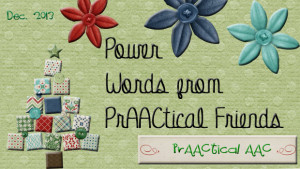
Teaching core vocabulary is the best way to pack a lot of power into an AAC system. As some of you know, we post things to the PrAACtical AAC Facebook Page a few times/day. Recently, we shared a link to a core word board from the I Can Newsletter folks that was posted on Boardmaker Achieve. We asked for suggestions for what you could say with those words. Here’s are some great ideas from our prAACtical friends: Come again: Love that this can be used in a literal sense, but also as a snarky comment Get help Go away: Language learning and self-advocacy – this one’s a two-fer! Your bad Stop it. Ready, go! Go get it. I like it. I want all done! I want more You do/did it. You stop it. You want it. What you want? We’ll take any opportunity to model questions and teach how to... [Read More...]
Filed under: PrAACtical Thinking
Tagged With: Boardmaker Achieve, communication book, core vocabulary, I Can
December 19, 2013
by Robin Parker -
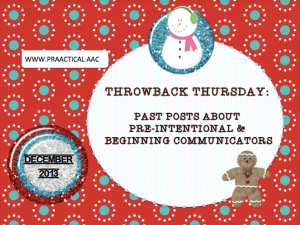
The Strategy of the Month for December is about Pre-Intentional and Beginning Communication. We knew this topic meant a lot to us because these learners are often overlooked or given up on just when they need help the most. We didn’t realize how important it was to us, until we started ’rounding up’ our past posts and found so many. We are fortunate to have worked with many pre-intentional and beginning communicators because they often teach us the most, and we love learning. Presuming Competence 3 Responses to Programs that Make Kids “Prove Worthiness” Prior to Providing Access to AAC Does AAC Benefit Individuals with Profound & Multiple Disabilities Strategy of the Month Strategy of the Month: Supporting Pre-Intentional Communicators Breaking Through with Pre-Intentional & Beginning Communicators of All Ages Supporting Pre-Intentional Communicators Teaching Basic Requests Making it Work: The PrAACtical Side of Therapy to Teach Requests Literacy Lessons for... [Read More...]
Filed under: PrAACtical Thinking
Tagged With: beginning communiator, beginning communicators
December 18, 2013
by Carole Zangari -

Deanne Shoyer, from Small But Kinda Mighty, has been sharing some fantastic ideas for building language in kids who are learning AAC. In this video, she shows how she used a visual scene display on a mobile device, Scene Speak (Good Karma Apps) to facilitate literacy and core vocabulary. You can read Deanne’s post about it here. Direct Link to Video: https://www.youtube.com/watch?v=yoeo1Z9Fqno
Filed under: PrAACtical Thinking
Tagged With: Apps, Good Karma Apps, literacy, Scene Speak, visual scene displays
December 17, 2013
by Carole Zangari -
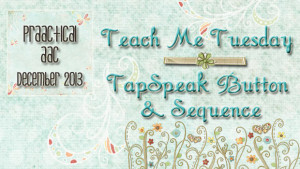
We love single message and sequential message communicators for their ease and flexibility. This week in Teach Me Tuesday we’re learning more about the various versions of TapSpeak Button and Sequence. Here are the learning resources we’ll be using. TapSpeak Button User Guide and Forum TapSpeak Sequence User Guide and Forum Videos Where to Go for Help If you know of other applicable resources, please add them in a comment below. See you next time!
Filed under: PrAACtical Thinking
Tagged With: Apps, TapSpeak, Teach Me Tuesday
December 16, 2013
by Carole Zangari -

We were looking for some core vocabulary lists the other day and it struck us: Maybe you were, too! Here are some we found, both for core words and other AAC-related topics. Core Vocabulary Adults – Baladin& Iacono, 1999 via Minspeak.com Adults – Hill, 2001 via Minspeak.com Toddlers – Banajee et al. 2003 via Minspeak.com Children [UNL] Preschool Children – Marvin et al. 1994 via Minspeak.com Children (combined sources) – Anderson & Bitner, 2013 Common core related words [UNC CLDS] Young adults [UNL] Older adults [Stuart, et al., 1997, via Minspeak.com] Various classroom, academic, and related lists [Gail Van Tatenhove] ALS [UNL] Break time at work [UNL] Dolch words: PreK through 3rd grade Medically-oriented [UNL] Young children [UNL] Know of one that we should add to the list? Please comment or get in touch so we can add it in. ::::::::::::::::::::::::::::::::::::::::::::::::::::::::::::: UNC: University of North Carolina UNL: University of Nebraska-Lincoln
Filed under: PrAACtical Thinking
Tagged With: core vocabulary, Gail Van Tatenhove, Minspeak, University of Nebraska, University of North Carolina, vocabulary list
December 13, 2013
by Carole Zangari -
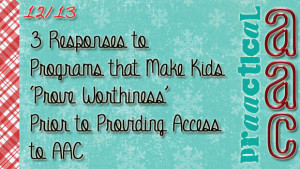
Like many of you, we continue to hear about programs that withhold AAC supports from children who are nonverbal or minimally verbal. Sometimes they point to the perceived lack of readiness that the child has for AAC, in general. Other times, they erect barriers, such as an artificial benchmark that insists that children start with no-tech AAC (e.g., communication boards, books, PECS) or low tech SGDs before ‘earning the right’ to sophisticated AAC options. As yet another year comes to a close, it is hard to believe that there are still programs, administrators, or, worse yet, our SLP colleagues who think they are truly justified in limiting access to AAC. How can we move beyond tearing our hair out, drinking excessively, or ranting to our friends? Here are some ideas. “Show me the evidence.” Ask for empirical support for the position that withholding access to AAC tools and strategies is more... [Read More...]
Filed under: PrAACtical Thinking
Tagged With: barrier, participation model, prerequisites, rationale
December 12, 2013
by Robin Parker -
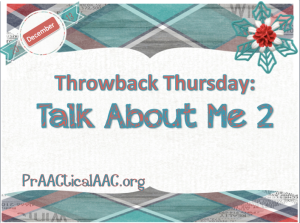
originally published December 13, 2012 We write about a lot of AAC strategies and we often give examples of different types of learners. Sometimes the learners we work with have more challenges than we explain. Lest you think, we do not see the really ‘challenging’ learners, we do, we really do. For those individuals with more challenges than most, sometime we are asked, well what do a few visual supports or AAC strategies do? What difference do they make? The truthful answer is A LOT. Here are a just a few recent examples from some really amazing families. When a mom is on the phone, a young adult brings in a timer and sets it so mom will get off the phone and go sit with her. When a communication book is forgotten on an emergency trip to the dentist, drawing on a napkin is enough to keep everyone calm... [Read More...]
Filed under: PrAACtical Thinking
Tagged With: Challenging Behavior, Complex Communication Needs, Visual Strategies
December 10, 2013
by Carole Zangari -

For most SLPs, it is easy to see how AAC can be beneficial to someone with motor difficulties, like cerebral palsy or ALS. To say that AAC strategies and technologies can be life-changing for these individuals is not an understatement. Similarly, the fields of SLP and special education now recognize that visual supports and AAC options are a standard of care for people affected by autism who have little or no functional speech. Not only does AAC provide a means for functional communication, but it also plays facilitative important role in speech and language development. To be sure, there are significant challenges in the implementation of AAC supports and services with these populations, but the practices themselves are now widely recognized for their positive impact on communication, literacy skills, independence, and behavior. But what about individuals with the most significant learning challenges? In this post, we share an article looking... [Read More...]
Filed under: PrAACtical Thinking
Tagged With: beginning communicator, intellectual disability, PMLD, prelinguistic communication, research support
December 9, 2013
by Carole Zangari -

. A strange thing happened while we were busy thinking and writing about AAC. Two strange things, actually. First, we got nominated for the 2013 Edublog Awards by fellow SLP bloggers. (Many thanks to those who put our name into the hat in the Individual Blog and Resource Sharing categories.) Then, we became finalists. Not too shabby for a low incidence topic like AAC! The cool thing about these nominations is that it is yet another way to raise awareness about AAC. It must be working because we’re hearing from professionals who are curious about what AAC is and how it relates to their area of interest, language. There are many deserving nominees in both categories. We listed our nominees here. Take a moment to vote for your favorites. They are ALL winners! Best Individual Blog 2013 – Edublog Awards Best Resource Sharing Blog 2013 – Edublog Awards View more lists from... [Read More...]
Filed under: PrAACtical Thinking
Tagged With: Awards, Edublogs, vote
December 6, 2013
by Carole Zangari -

In the US, you’d be hard pressed to find a graduate program in SLP that didn’t have required courses in fluency and voice disorders. Only a minority of SLP programs, though, require students to take a course in AAC. How does this compare to the needs in the field? Not so well, in our humble opinion. ASHA’s 2013 SLP Health Care Survey obtained responses from more than 800 SLPs who work with children in healthcare settings, such as hospitals, outpatient clinics, and home health. On average, they spent more time on AAC services than on services for fluency, voice, or resonance disorders. When asked what percentage of their time was spent providing services in different categories, here’s what the participating SLPs reported: AAC: 5.5% Fluency: 3% Voice: 2% Resonance: 1.3% We acknowledge that requiring graduate students to take courses in specific disorder areas isn’t the only way to help them... [Read More...]
Filed under: PrAACtical Thinking
Tagged With: healthcare









